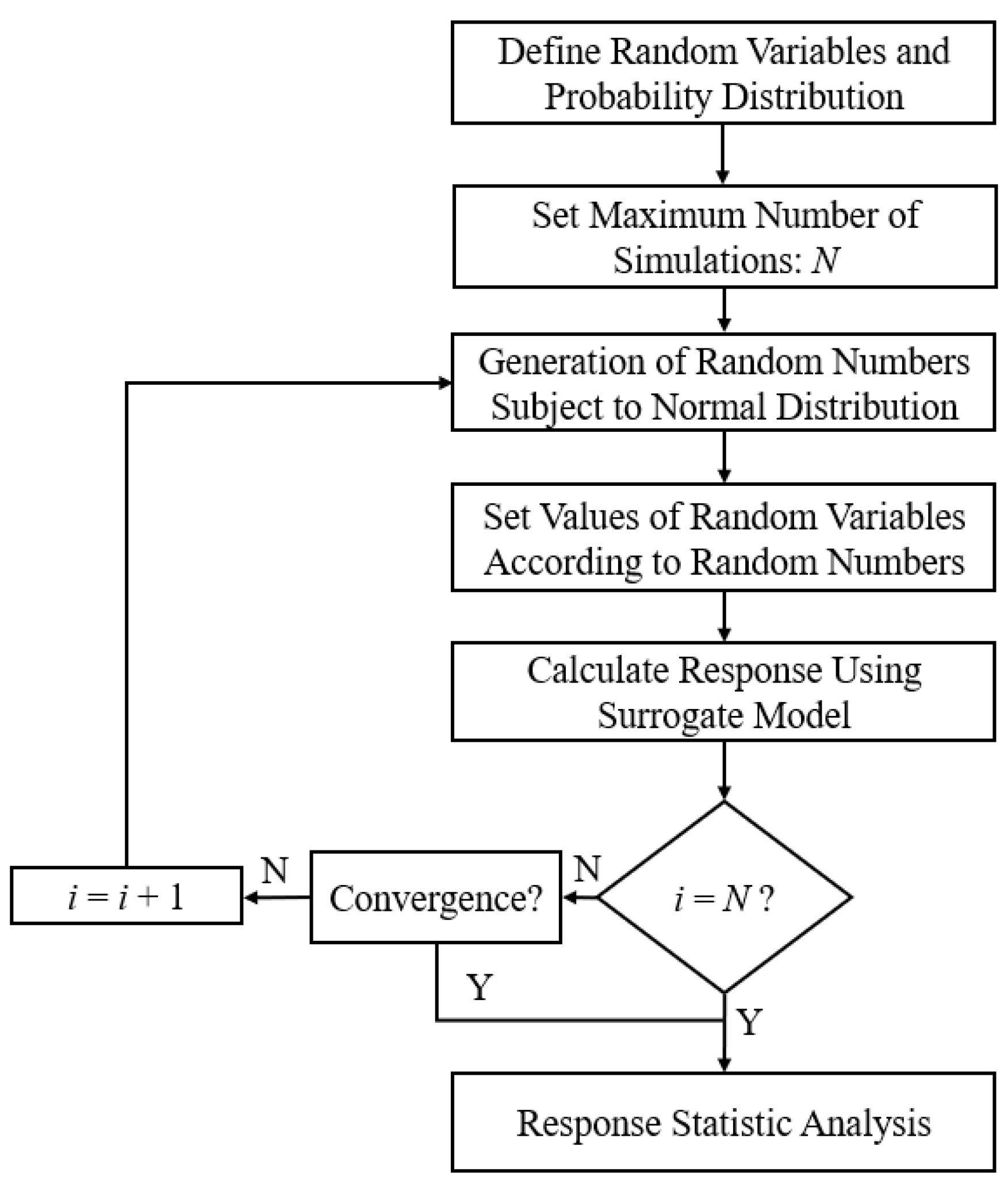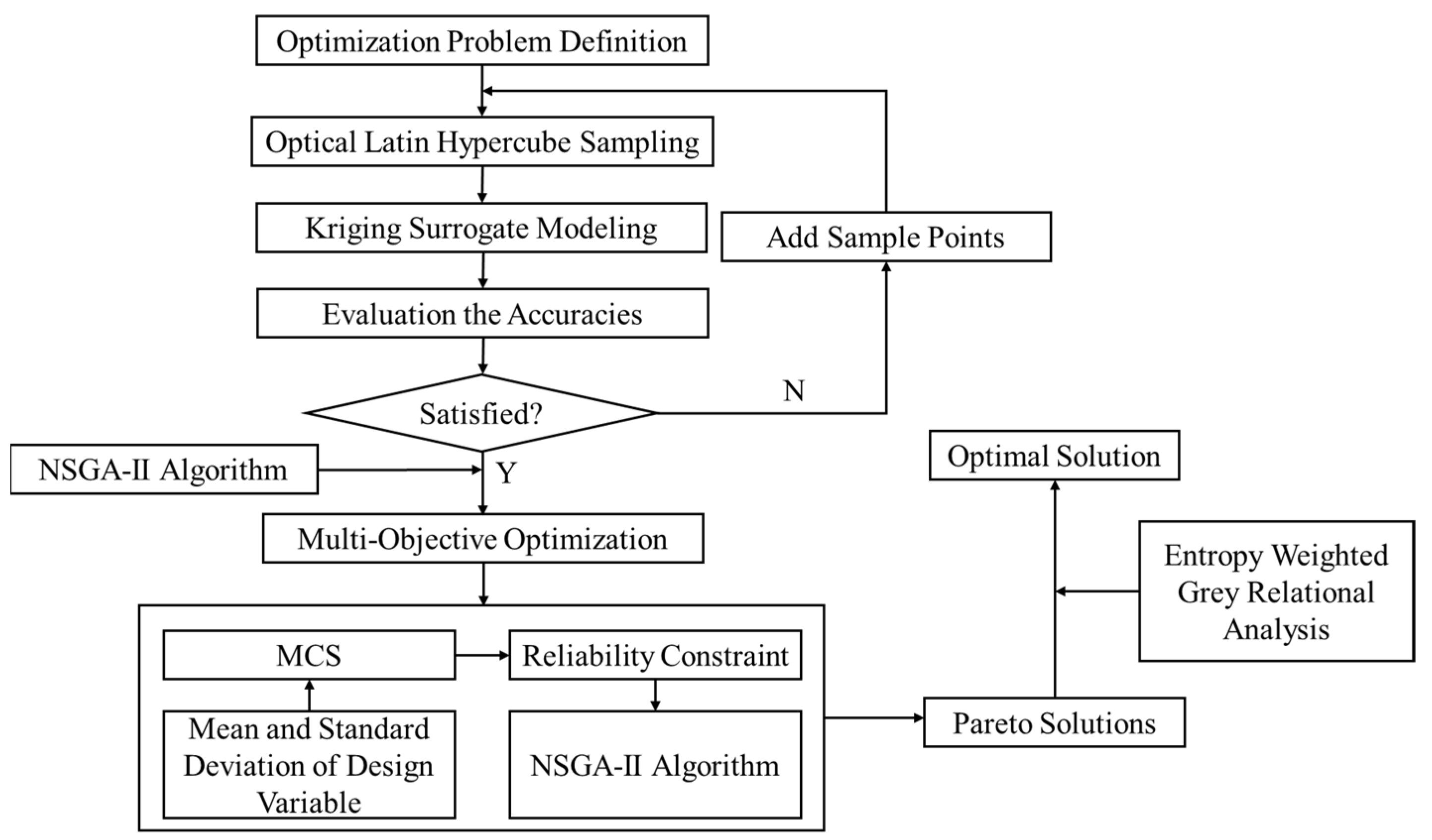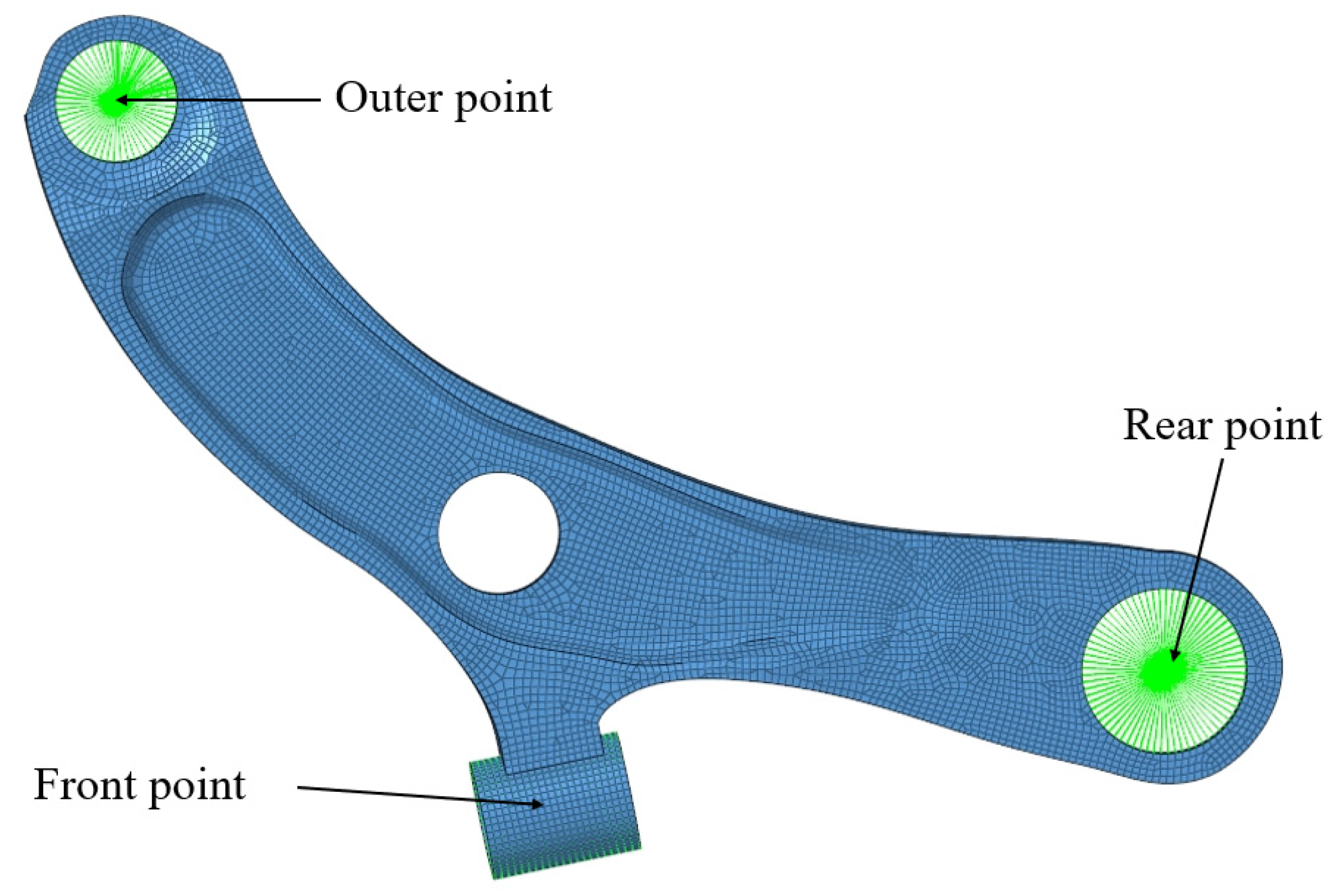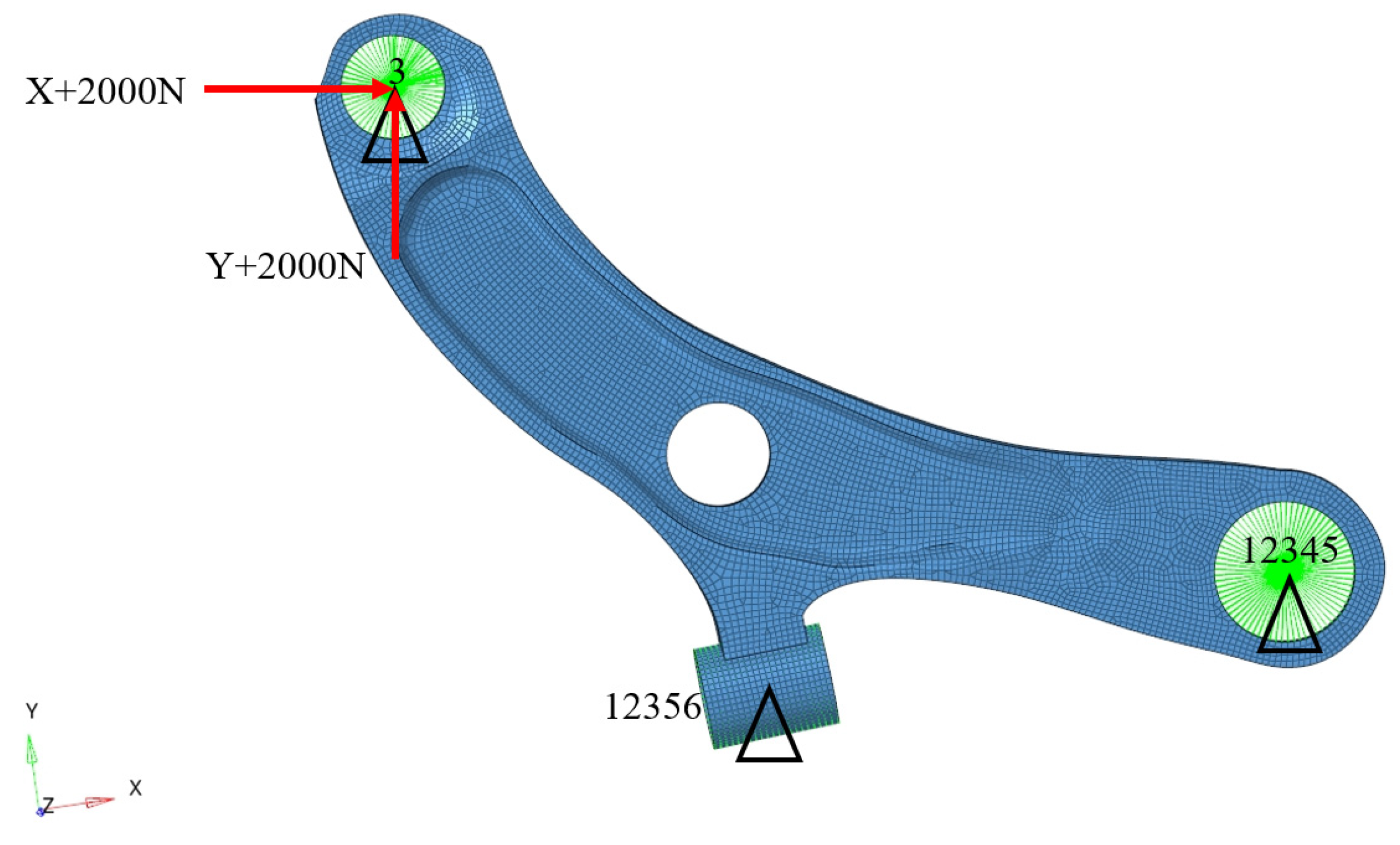1. Introduction
With the continuous growth of car ownership, automobile exhausts emit a large number of pollutants. Additionally, the fuel consumption problem is becoming increasingly serious. In order to reduce the environmental and energy problems caused by the development of the automobile industry, making an automobile lightweight has become one of the effective measures [
1,
2,
3]. A suspension control arm has to bear and transfer various loads caused by road roughness and engine vibrations. Thus, its thickness is always set to be thicker to ensure vehicle safety, which leads to the weight of the suspension system also being greatly increased. Therefore, it is of great significance to carry out a lightweight design of the control arm on the premise of ensuring its stiffness, strength, and fatigue life [
4,
5,
6].
Scholars have paid much attention to automobile lightweight solutions, including optimization design, the application of lightweight material, and advanced manufacturing processes. Mohd et al. [
7] optimized the topology of an aluminum control arm and proposed the optimal material layout method based on load and boundary conditions, which achieved a mass reduction of 41% under the condition of satisfying the strength. Yoo et al. [
8] replaced the aluminum used for the control arm with carbon fiber-reinforced polymer and carried out topology optimization. At the same time, under the conditions of multiple constraints including stiffness and durability, the weight was reduced by 30%. Zhang [
9] changed the material of automobile B-pillar from metal to carbon fiber-reinforced polymer, which not only reduced the mass by 50.76%, but also greatly improved the crashworthiness. Guler et al. [
10] developed automobile hinge components with PA66 GF60 glass fiber-reinforced polyamide composite instead of ordinary steel. Topology optimization was carried out under a specific load to obtain the optimal size and minimum mass. Chen et al. [
11] designed a new single stamping control arm and achieved a mass reduction of 33.3% compared to the original one through topology optimization and size optimization.
For engineering optimization problems, there are usually two or more objectives that need to be achieved. Generally, these objectives are in conflict with each other. Traditional single objective optimization often focuses on one key optimization performance while ignoring the correlation with the other performance. Multi-objective optimization methods are proposed to select the Pareto solutions in many engineering fields. Wang et al. [
12] designed a new bumper system composed of negative Poisson’s ratio (NPR) beam and NPR absorber, and used a multi-objective optimization algorithm to search for the optimal structural parameters. The results show that the performance of pedestrian protection and vehicle crashworthiness was improved. Fossati et al. [
13] used the multi-objective optimization method to optimize the passive suspension system of a whole vehicle model running on a random road, which achieved a reduction of 21.14% for the weighted mean square root of vertical angular velocity of the driver seat. Based on the Kriging surrogate model, Tang et al. [
14] used a multi-objective genetic algorithm to optimize the thickness of acoustic package material. Under the condition of ensuring that the acoustic performance of automobile acoustic package remained unchanged, the mass was reduced by 20.76%. Nikkhah et al. [
15] optimized the thin-walled tube with the aim of maximizing specific energy absorption (SEA) and minimizing peak crushing force (PCF). Response surface methodology (RSM) was established to find the optimal configuration of the tube for improving the energy absorption characteristics of the thin-walled tube.
Reliability is the probability that a product will not fail. The failure probability of the product is closely related with the uncertainty of design parameters [
16,
17]. The traditional optimization design is usually performed without considering the uncertainty of input variables, which may lead to failure of the optimization results in practical application. Therefore, reliability optimization has attracted much attention recently. Lim et al. [
18] proposed a reliability-based multi-objective optimization design method to optimize the engine mount. They obtained a more reliable optimization solution than the deterministic optimization based on the NSGA algorithm. Zhang et al. [
19] presented a new method for hybrid reliability-based design optimization under random and interval uncertainties, and used a ten-bar truss example and a design of piezoelectric energy harvester to verify the accuracy and effectiveness of the method. Combined with the response surface method and a multi-island genetic algorithm, Li et al. [
20] applied an efficient reliability-based design optimization process to optimize the reliability of lattice boom. The results showed that it not only met the reliability requirements, but also ensured safety and economy.
In this paper, a multi-objective reliability optimization method by integrating MCS with NSGA-II algorithm coupled with entropy weighted GRA is proposed, and the effectiveness of this method is verified by the lightweight optimization of the lower control arm of Macpherson suspension. Firstly, the finite element model of the control arm is established and the modal and stiffness analysis are carried out. Then, the inertial release method is used to calculate the stress distribution of the control arm under unit load. The load time histories of the control arm are extracted by dynamic simulations of the rigid-flexible coupling vehicle model. Accordingly, the nominal stress method is used to calculate the fatigue life of the control arm. On this basis, six design variables are defined for describing geometric dimension of control arm based on mesh morphing technology. The optimal Latin hypercube method is applied to generate the sample points for constructing Kriging surrogate models, which are used to describe the relationships between design variables of control arm and its structure performance including mass, fatigue life, stiffness, and mode. The multi-objective reliability optimization of the control arm is further performed by combining the NSGA-II algorithm and the Monte Carlo simulations. Finally, the entropy weighted grey relational analysis is adopted to determine the optimal solution from Pareto set for realizing lightweight design of the control arm.
6. Conclusions
This paper proposed a multi-objective reliability optimization method based on Monte Carlo simulation, NSGA-II algorithm and entropy weighted grey relational analysis, applied to perform the lightweight design of a lower control arm of McPherson suspension. The finite element model of the control arm was developed to conduct the modal and stiffness analysis. The fatigue life of the control arm was predicted by a normal stress method, using the load spectrum acquired by dynamic simulations of the rigid-flexible coupling vehicle model running on the virtual durability road. Then, the deterministic multi-objective optimization of the control arm was carried out to minimize the mass and maximize the fatigue life with the constraints of first order natural frequency and longitudinal and transverse stiffness, based on the Kriging model and NSGA-II algorithm. The deterministic optimization results showed that the mass of the control arm was reduced from 3.16 kg to 2.88 kg with a reduction of 8.89%, and the life was reduced by 22.47% from 1.39 × 106 to 1.08 × 106, with a reliability of 90%.
On this basis, the multi-objective reliability optimization of the control arm was conducted using the NSGA-II algorithm and the Monte Carlo simulations. The entropy weighted grey relational analysis was adopted to determine the optimal design of the control arm from the Pareto solutions. The reliability optimization results indicated that the mass of the optimized control arm was reduced by 4.1% and the life was increased by 215.8% with a high reliability of 97%. This proves that the proposed multi-objective reliability optimization procedure is effective for automotive lightweight design.




















